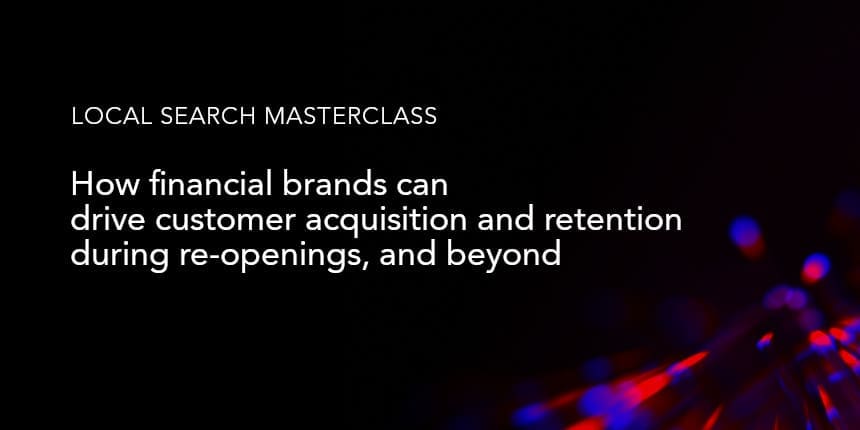
 Local-search-masterclass-recap-how-...
Local-search-masterclass-recap-how-... 
Reopening can be complicated for businesses with distributed local footprints, especially in the highly regulated financial services industry. That’s why we hosted a Local Search Masterclass to help industry marketers get the most valid information in front of their audiences as they look to return to physical locations.
Some key insights in this masterclass included:
- Why operational messaging is important to drive deposits
- What you can and should be doing to get this right digitally
- How and where to make updates
- What to prepare for in the coming months
Why operational messaging is important to drive deposits
In some regions, banks have already begun to reopen while others are getting ready to follow suit. What reopening looks like will vary but, overall, customers will expect to be able to return and will want to know what is happening at their local branches. Customers are looking to your digital presence to know what you are currently doing, what your hours are, what services are available, and what may be different compared to their last visit.
Unsurprisingly, user interest in “reopening” is spiking, especially for banks. These queries are seeing explosive traffic right now so it’s imperative to meet that demand. Consumer expectations are also changing; for example, there is a surge in searches for mobile banking, so providing answers to those topics of interest will be imperative.


Just reopening does not mean a return to normal. Many are not expecting things to get back to normal. So, instead, how to we ease into the transition to the new normal? By getting the operational messaging right so customers can build confidence about visiting physical locations.
To prepare the right messaging, we need to look at Google My Business (GMB) and make sure that each component is handled correctly. Why? Because your GMB profile is most likely where consumers find you first. As crazy as it sounds, GMB is more likely to drive traffic than your website.
Here’s what you can do:
-
Google My Business
Make sure your business is marked as open and update special hours if applicable. Secondary hour updates make sense as well so you can inform your consumers about things like branch hours vs. drive through hours. This will get you closer to answering some of the questions customers will have before they ever show up.
Update categories to ensure you are ranking for the queries that will drive traffic, leads, and deposits.
If you added a descriptor to your business name during COVID-19, make sure you change that back to your official business name.
Double check phone number(s) to ensure they’re going to the right place. If you switched to a central 800 number, make sure you switch back to the local branch. For call tracking, ensure it is set as your primary number.
Business descriptions are another great way to help consumers feel comfortable before they visit your location. Include service offerings, possibility of longer wait times, and safety protocols that may be in place.

-
Additional features
Google Posts are another great way to get that content clearly and concisely communicated. Visitors are already looking at your listing, so having posts geared specifically to finer details will provide more options. Your posts are housed within the updates tab on mobile, so this is a great place to post your latest information as well as events and community services you are focusing on. Is your virtual offering continuing? Many consumers opted in to mobile banking for the first time during COVID-19 out of necessity. Many have gotten used to doing this more, so it’s important to let consumers know this isn’t going away, that this service is still going to continue. What’s paramount here is to educate that consumers have options available to them.
Make use of the Q&A section. People could be asking questions about hours, sanitation protocols, and more. See it as an extension of customer service. Monitoring this is very important.
As for Attributes, ensure your amenities, offerings, and accessibility represent your current operational status.
Update your website URL if you moved links to the homepage instead of store pages. You can now switch those back to direct traffic to your local pages and ensure an intuitive user experience.
-
Reviews
Review functionality has been restored so make sure your process to respond is also up and running again. And don’t forget to analyze those reviews coming in; they could be a treasure trove of consumer feedback.
Ask customers what they think of your safety protocols. This content could be persuasive to new and existing customers (as long as it’s positive!)
-
Beyond Google
On other sites and directories like Apple, Bing, Facebook, Foursquare, don’t forget to undo temporary closures, confirm business information, update special hours, and review pinned posts, specifically on Facebook.
Your website is your one true owned entity, so although many will reference information on your listings, they’ll likely click through to your website to confirm that information is up to date and matches. Confirm your operational status through a banner or special announcement that is hard to miss.
Return to the new normal
Remember it’s not just business as usual. Educate customers and support them through the change. Stress how you’re supporting customer safety. Remember that consumer habits most likely have changed, so plan to position your business in this new world appropriately.
Finally, pay attention to how geography will alter your strategy. There are very different regulations depending on physical location. Keeping that in mind as you craft operational messaging will be paramount.
Want to see for yourself? Watch the masterclass recording here.

